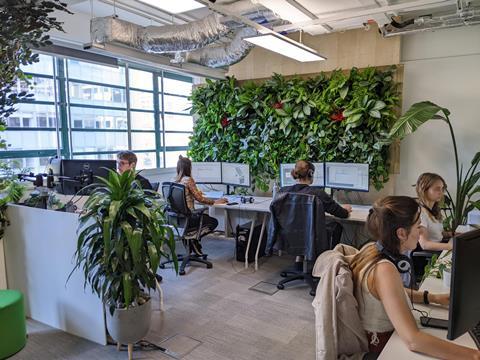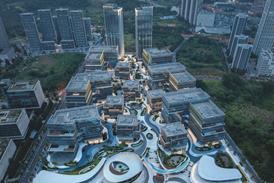From increasing workplace productivity and improving indoor air quality to influencing the behaviour of consumers, Adrian Byne shares his expertise on the power of plants

The emphasis on creating spaces that foster human health and wellbeing has become a hot topic in construction and interior design across many sectors. How can we create spaces that are functional but also offer tangible physical and mental benefits to its inhabitants?
One area that has garnered significant attention is the integration of plants into indoor environments as part of a growing interest in the benefits of biophilic design.
In a recent study published by PLP Labs – experts in workspace design, environmental psychology and biophilic design – compelling evidence was provided of the impact plants can have on individuals’ physical and mental health in the workplace.
The study, titled ‘Reap What You Sow’, delved into the effects of incorporating biophilic design into the workplace environment. According to the findings, offices with ample greenery experienced a remarkable 200% increase in employee wellbeing.
Recent survey findings from the Chartered Institute of Personnel and Development and Simplyhealth have revealed that absence rates in the UK are currently at a 10-year high. The Reap What You Sow study also shed light on the positive influence of plants on mental wellbeing and reduced rates of absenteeism; employees reported a 38% reduction in stress levels when working in environments enriched with plants. Additionally, the presence of greenery led to a 58% increase in creativity and problem-solving abilities among workers, underscoring the role of plants in enhancing cognitive function.
Integrating plants into any space goes beyond mere aesthetics; it involves strategic placement and thoughtful selection to maximise their benefits. Creative plant design encompasses various approaches, including living walls, vertical gardens, standalone planters and biophilic design elements that mimic natural environments.
Living walls serve as striking focal points while improving air quality and reducing noise levels. These vertical gardens not only enhance the visual appeal of a space but also contribute to a sense of tranquillity and connection with nature.

The impact of creative plant design extends beyond the confines of the workplace, transcending into diverse sectors such as education, hospitality, and retail.
In educational settings, integrating plants into classrooms and study areas can significantly enhance the learning experience. Studies have shown that students in classrooms with plants demonstrate improved concentration, leading to better academic performance.
Furthermore, greenery creates a conducive environment for creativity and critical thinking, nurturing young minds and fostering a love for learning.
Hotels, bars and restaurants can leverage plants to create memorable guest experiences. From lush indoor gardens to enticing entrances, greenery - even life-like artificial plants and flowers - add elegance and serenity to hospitality spaces. Guests are drawn to the visual beauty of plants but also benefit from the soothing ambience they create, making customers more inclined to remain longer and repeat their patronage. Additionally, indoor plants contribute to better air quality, ensuring a healthier environment for patrons and staff alike.
In retail environments, the strategic placement of plants can enhance the shopping experience and drive sales. Studies have shown that shoppers are more likely to linger and make purchases in stores adorned with greenery. Plants create a sense of relaxation and comfort, encouraging customers to explore at a leisurely pace. Moreover, incorporating natural elements into retail spaces aligns with the growing demand for sustainable and eco-conscious shopping experiences, resonating with environmentally conscious consumers.
Creative plant design holds immense potential for improving human health and wellbeing across various sectors. For architects and building construction professionals, embracing plants presents an opportunity to create spaces that prioritise the wellbeing of occupants. As the demand for healthier and more nurturing spaces continues to rise, integrating plants into architectural design will undoubtedly play a pivotal role in shaping the future of the built environment.
Postscript
Adrian Byne is the director at Benholm Group
















No comments yet